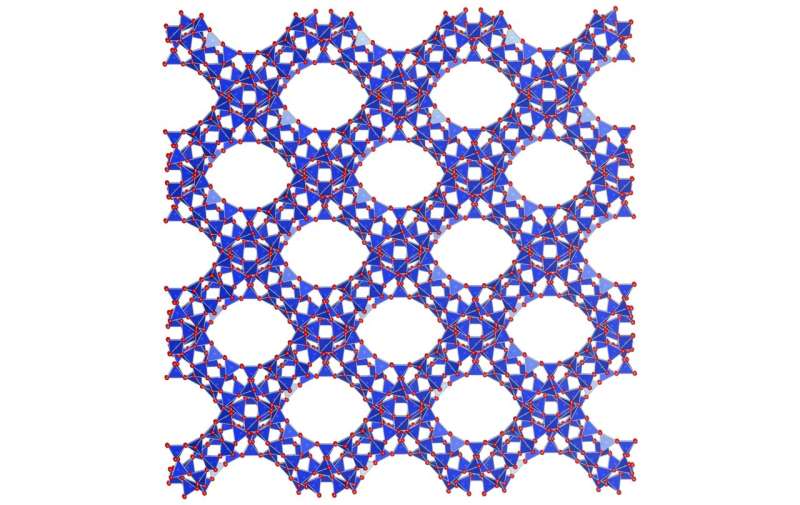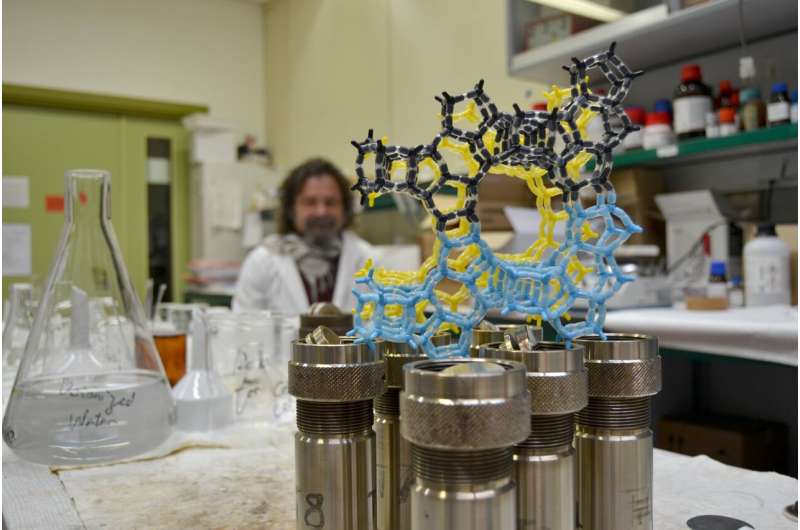This article has been reviewed according to Science X's editorial process and policies. Editors have highlighted the following attributes while ensuring the content's credibility:
fact-checked
peer-reviewed publication
proofread
Researchers create a new 3D extra-large pore zeolite that opens a new path to the decontamination of water and gas

An international team of researchers, with the participation of the Spanish National Research Council (CSIC), has created the most porous stable zeolite known to date, a new pure silica zeolite called ZEO-3. This zeolite was formed by an unprecedented topotactic condensation of a 1D silicate chain to a 3D zeolite.
The process is topotactic because the structure of the chain is not altered. It can be applied to remove and recover volatile organic compounds from a gas stream that may even contain water. The discovery, to which scientists from the Institute of Materials Sciences of Madrid (ICMM-CSIC) and the Institute of Nanoscience and Materials of Aragon (INMA-CSIC-UNIZAR) have contributed, is published in the journal Science.
Zeolites are microporous silicates that find an ample variety of applications as catalysts, adsorbents, and cation exchangers. Stable silica-based zeolites with increased porosity are in demand to allow adsorption and processing of large molecules, "but challenge our synthetic ability," explains Miguel Camblor, researcher at ICMM and one of the corresponding authors of the research.
As the zeolites pores are the size of small molecules, there is a limitation on the size of molecules you can process. That is why zeolites with larger pores have always been sought and, specially, those with inpores along three dimensions. "When you have a pore in only one direction, even if it is large, it is easy for it to be blocked, but if you have them in all dimensions, it's difficult," Camblor says.
After more than 80 years of extensive international research in this field, this team has created the most porous stable zeolite known so far. "Until now, the zeolites with extra-large pores were not stable, as they were made by germanium instead of siliconm," he says. Previous stable zeolites could reach up to 7 angstroms.
Last year, this team of researchers published another article in Science about a new zeolite with aluminum and large pores (ZEO-1). Now, the new zeolite has a composition of pure silica. "In both zeolites, ZEO-1 and ZEO-3, there are pores that reach more than 10 angstroms," says Camblor.

The peculiarities of ZEO-3
This new zeolite has two peculiarities: extra-large pores in all three dimensions and it is formed though the synthesis by calcination of a one-dimensional chain silicate in a topotactic condensation (what means it was made without changes in this chain).
"This had never been seen before," says Camblor. "Two-dimensional to three-dimensional topotactic condensations were known, that is, a thing that was lamellar and that by a similar mechanism condensed to give a zeolite, but not from one-dimensional to three-dimensional," he adds.
After the creation of this zeolite the team, with researchers also from Sweden, China and U.S., started to experiment wiht its properties. "Since this is a material that is pure silica, it does not have a catalytic capacity, but it has a capacity to absorb very large things. Big organic stuff," says Camblor.
"This zeolite can be applied to remove and recover volatile organic compounds from a gas stream that may even contain water," he explains. "In a site where harmful volatile organic materials are being produced, you can decontaminate and not just remove it but recover the contaminant," Camblor illustrates. With further research this zeolite could be also useful at catalysis and in drug delivery.
More information: Jian Li et al, A 3D extra-large-pore zeolite enabled by 1D-to-3D topotactic condensation of a chain silicate, Science (2023). DOI: 10.1126/science.ade1771. www.science.org/doi/10.1126/science.ade1771
Journal information: Science
Provided by Spanish National Research Council




















